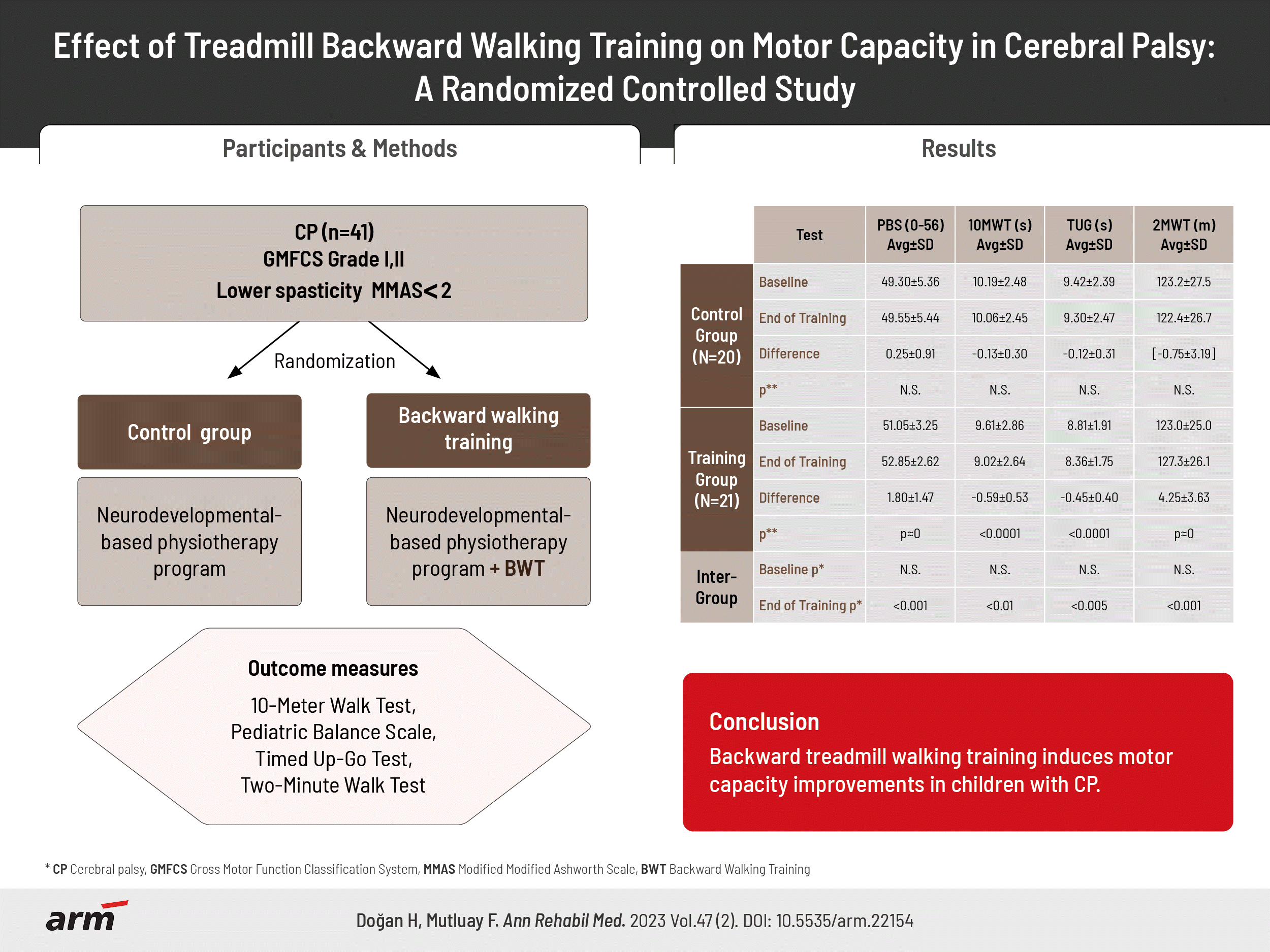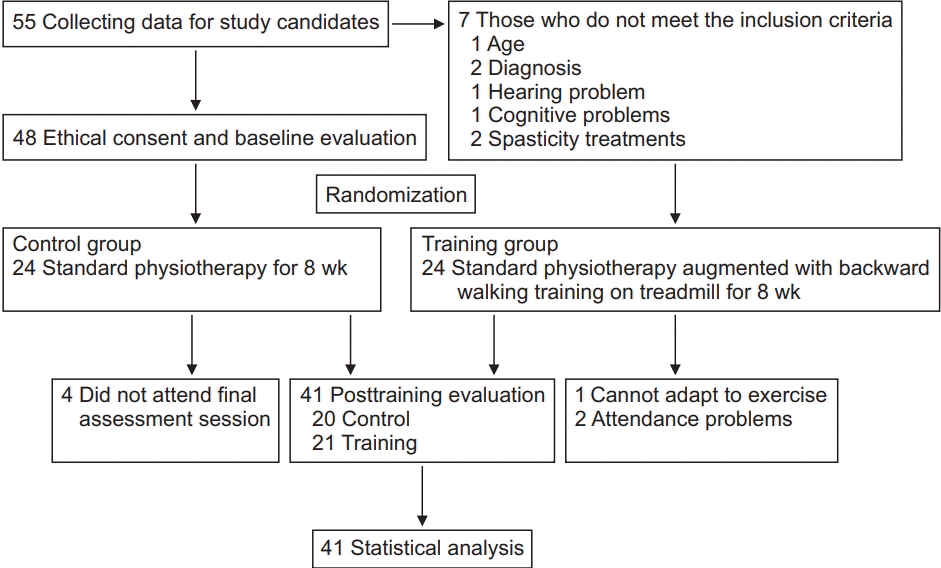1. Rosenbaum P, Paneth N, Leviton A, Goldstein M, Bax M. A report : the definition and classification of cerebral palsy April 2006. Dev Med Child Neurol. 2007; 49(Suppl 109):8–14.
2. Bjornson KF, Belza B, Kartin D, Logsdon R, McLaughlin JF. Ambulatory physical activity performance in youth with cerebral palsy and youth who are developing typically. Phys Ther. 2007; 87:248–57.

3. Gage JR, Novacheck TF. An update on the treatment of gait problems in cerebral palsy. J Pediatr Orthop B. 2001; 10:265–74.

4. Smania N, Bonetti P, Gandolfi M, Cosentino A, Waldner A, Hesse S, et al. Improved gait after repetitive locomotor training in children with cerebral palsy. Am J Phys Med Rehabil. 2011; 90:137–49.

5. Elnahhas AM, Elshennawy S, Aly MG. Effects of backward gait training on balance, gross motor function, and gait in children with cerebral palsy: a systematic review. Clin Rehabil. 2019; 33:3–12.

6. Damiano DL, Wingert JR, Stanley CJ, Curatalo L. Contribution of hip joint proprioception to static and dynamic balance in cerebral palsy: a case control study. J Neuroeng Rehabil. 2013; 10:57.

7. Emara HA, El-Gohary TM, Al-Johany AA. Effect of body-weight suspension training versus treadmill training on gross motor abilities of children with spastic diplegic cerebral palsy. Eur J Phys Rehabil Med. 2016; 52:356–63.
8. Richards CL, Malouin F, Dumas F, Marcoux S, Lepage C, Menier C. Early and intensive treadmill locomotor training for young children with cerebral palsy: a feasibility study. Pediatr Phys Ther. 1997; 9:158–65.
9. Terblanche E, Page C, Kroff J, Venter RE. The effect of backward locomotion training on the body composition and cardiorespiratory fitness of young women. Int J Sports Med. 2005; 26:214–9.

10. Yang YR, Yen JG, Wang RY, Yen LL, Lieu FK. Gait outcomes after additional backward walking training in patients with stroke: a randomized controlled trial. Clin Rehabil. 2005; 19:264–73.

11. Flynn TW, Connery SM, Smutok MA, Zeballos RJ, Weisman IM. Comparison of cardiopulmonary responses to forward and backward walking and running. Med Sci Sports Exerc. 1994; 26:89–94.

12. Hoogkamer W, Meyns P, Duysens J. Steps forward in understanding backward gait: from basic circuits to rehabilitation. Exerc Sport Sci Rev. 2014; 42:23–9.
13. Kramer J. Backward walking: a cinematographic and electromyographic pilot study. Physiother Can. 1981; 33:77–86.
14. Threlkeld AJ, Horn TS, Wojtowicz G, Rooney JG, Shapiro R. Kinematics, ground reaction force, and muscle balance produced by backward running. J Orthop Sports Phys Ther. 1989; 11:56–63.

15. Franjoine MR, Gunther JS, Taylor MJ. Pediatric Balance Scale: a modified version of the berg balance scale for the school-age child with mild to moderate motor impairment. Pediatr Phys Ther. 2003; 15:114–28.

16. Witherspoon JW, Vasavada R, Logaraj RH, Waite M, Collins J, Shieh C, et al. Two-minute versus 6-minute walk distances during 6-minute walk test in neuromuscular disease: Is the 2-minute walk test an effective alternative to a 6-minute walk test? Eur J Paediatr Neurol. 2019; 23:165–70.

17. Abdel-Aziem AA, El-Basatiny HM. Effectiveness of backward walking training on walking ability in children with hemiparetic cerebral palsy: a randomized controlled trial. Clin Rehabil. 2017; 31:790–7.

18. Abdou R, El-Negamy E, Hendawy A. Impact of backward gait training on Mediolateral stability index in children with hemiparesis. J Med Sci Clin Res. 2014; 2:2042–9.
19. Hegazy RG. Impact of backward treadmill walking on balance in children with diplegic cerebral palsy. Int J Ther Rehabil Res. 2017; 6:141–7.

20. Ayoub HESAA. Forward versus backward body weight supported treadmill training on step symmetry in children with spastic diplegia. Int J Physiother Res. 2016; 4:1639–45.

21. Ayoub HESAA. Impact of body weight supported backward treadmill training on walking speed in children with spastic diplegia. Int J Physiother. 2016; 3:535–9.
22. El-Basatiny HM, Abdel-Aziem AA. Effect of backward walking training on postural balance in children with hemiparetic cerebral palsy: a randomized controlled study. Clin Rehabil. 2015; 29:457–67.

23. Kim SG, Ryu YU, Je HD, Jeong JH, Kim HD. Backward walking treadmill therapy can improve walking ability in children with spastic cerebral palsy: a pilot study. Int J Rehabil Res. 2013; 36:246–52.
24. Sanad DAM. Conditioning effects of backward treadmill training in children with spastic diplegic cerebral palsy. Int J Physiother Res. 2017; 5:2294–300.

25. Palisano RJ, Rosenbaum P, Bartlett D, Livingston MH. Content validity of the expanded and revised Gross Motor Function Classification System. Dev Med Child Neurol. 2008; 50:744–50.

26. Ansari NN, Naghdi S, Younesian P, Shayeghan M. Inter- and intrarater reliability of the Modified Modified Ashworth Scale in patients with knee extensor poststroke spasticity. Physiother Theory Pract. 2008; 24:205–13.

27. Hanna SE, Bartlett DJ, Rivard LM, Russell DJ. Reference curves for the Gross Motor Function Measure: percentiles for clinical description and tracking over time among children with cerebral palsy. Phys Ther. 2008; 88:596–607.

28. Yi SH, Hwang JH, Kim SJ, Kwon JY. Validity of pediatric balance scales in children with spastic cerebral palsy. Neuropediatrics. 2012; 43:307–13.

29. Bohannon RW, Wang YC, Bubela D, Gershon RC. Normative two-minute walk test distances for boys and girls 3 to 17 years of age. Phys Occup Ther Pediatr. 2018; 38:39–45.

30. Pin TW, Choi HL. Reliability, validity, and norms of the 2-min walk test in children with and without neuromuscular disorders aged 6-12. Disabil Rehabil. 2018; 40:1266–72.

31. Chrysagis N, Skordilis EK, Koutsouki D. Validity and clinical utility of functional assessments in children with cerebral palsy. Arch Phys Med Rehabil. 2014; 95:369–74.

32. Nicolini-Panisson RD, Donadio MV. Normative values for the Timed ‘Up and Go’ test in children and adolescents and validation for individuals with Down syndrome. Dev Med Child Neurol. 2014; 56:490–7.

33. Chen CL, Shen IH, Chen CY, Wu CY, Liu WY, Chung CY. Validity, responsiveness, minimal detectable change, and minimal clinically important change of Pediatric Balance Scale in children with cerebral palsy. Res Dev Disabil. 2013; 34:916–22.

34. Johnston KN, Potter AJ, Phillips AC. Minimal important difference and responsiveness of 2-minute walk test performance in people with COPD undergoing pulmonary rehabilitation. Int J Chron Obstruct Pulmon Dis. 2017; 12:2849–57.





 PDF
PDF Citation
Citation Print
Print





 XML Download
XML Download